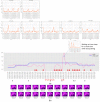Sleep Pattern Analysis in Unconstrained and Unconscious State
- PMID: 36501996
- PMCID: PMC9738183
- DOI: 10.3390/s22239296
Sleep Pattern Analysis in Unconstrained and Unconscious State
Abstract
Sleep accounts for one-third of an individual's life and is a measure of health. Both sleep time and quality are essential, and a person requires sound sleep to stay healthy. Generally, sleep patterns are influenced by genetic factors and differ among people. Therefore, analyzing whether individual sleep patterns guarantee sufficient sleep is necessary. Here, we aimed to acquire information regarding the sleep status of individuals in an unconstrained and unconscious state to consequently classify the sleep state. Accordingly, we collected data associated with the sleep status of individuals, such as frequency of tosses and turns, snoring, and body temperature, as well as environmental data, such as room temperature, humidity, illuminance, carbon dioxide concentration, and ambient noise. The sleep state was classified into two stages: nonrapid eye movement and rapid eye movement sleep, rather than the general four stages. Furthermore, to verify the validity of the sleep state classifications, we compared them with heart rate.
Keywords: NREM; REM; sleep pattern; sleep posture; unconscious; unrestraint.
Conflict of interest statement
The authors declare no conflict of interest.
Figures

























References
-
- [(accessed on 14 September 2022)]. Available online: https://www.philips.com/aw/about/news/archive/standard/news/press/2021/2....
-
- [(accessed on 14 September 2022)]. Available online: https://kokodoc.com/sleep-health-03/
-
- [(accessed on 14 September 2022)]. Available online: http://www.sleepmed.or.kr/content/info/sleeptime.html.
-
- Renevey P., Delgado-Gonzalo R., Lemkaddem A., Proença M., Lemay M., Solà J., Tarniceriu A., Bertschi M. Optical Wrist-Worn Device for Sleep Monitoring. In: Eskola H., Väisänen O., Viik J., Hyttinen J., editors. EMBEC NBC 2017. Volume 2018. Springer; Berlin/Heidelberg, Germany: 2017. pp. 615–618. - DOI
-
- 2004 After Rechtschaffen & Kale, 1968, Kalat, 2005, Weiten. [(accessed on 14 September 2022)]. Available online: https://www.basicknowledge101.com/subjects/sleeping.html.
MeSH terms
Grants and funding
LinkOut - more resources
Full Text Sources
Medical

